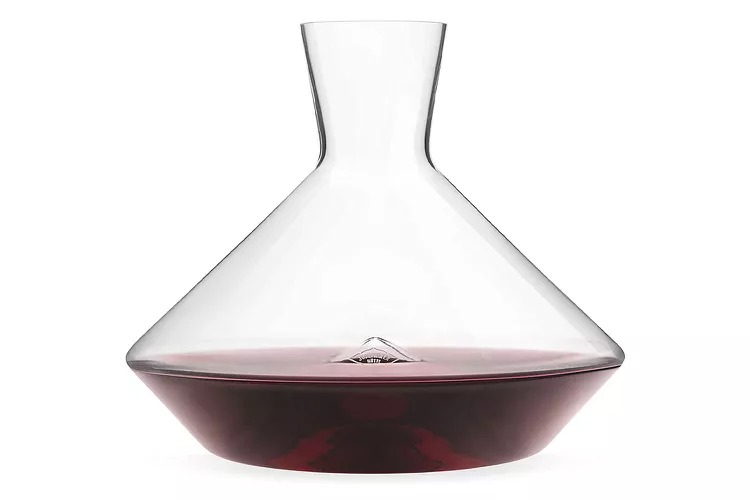Decanting and Aerating Wine
One of the best parts of drinking wine is experiencing all flavors in each sip. To allow your wine to reach its full potential, consider decanting or aerating wine. These processes will expand the aromatic profile and allow the wine to show its best. We’ll go through the details and differences of decanting and aerating, here.

What is decanting, and what is aerating?
Decanting wine is the act of pouring wine slowly from its original bottle into a large glass decanter. There are two primary reasons for decanting wine: removing sediment and allowing the wine to aerate. Sediment buildup is common in older red wines, and it is a natural process. While sediment is harmless and expected in some bottles of wine, you don’t want to drink it.
Aerating wine is what brings out all of the delicious notes and aromas from a bottle. It also lets sulfites and ethanol escape the wine, leaving you with pleasant flavors and aromas and nothing to interfere with them. Wine aeration tries to replicate the wine’s natural aging process, which happens over years when bottled in the cellar.
Although you may hear the terms “decanting” and “aerating” used interchangeably, aeration is a separate process that occurs after decanting. Both processes can be done on full-bodied whites as well as reds, although reds are far more common candidates.
The key difference between decanting and aerating wine
The key difference between decanting and aerating wine is time. Aeration happens almost instantly as the aerator passes wine through its nozzle. A decanted wine can take much longer, by comparison, but is always best if you are drinking a wine that needs to open. It is an overall gentler process.

How do I know when I need to consider decanting or aerating wine?
Aside from the time you have available, it’s also important to note the age of your wine. An older wine (10-15 years) should not be aerated but the sediment must be removed. If you’re serving an old wine at its peak, it won’t benefit from aeration, as it’s fully developed. The more an old wine is exposed to air the sooner it will start to fade, so in most cases, the wine should be decanted just prior to drinking it. Also, if you’re drinking red or white wines in a lower price point ($15.00 and under) they’re typically produced for quick and easy consumption and likely won’t benefit from additional air exposure.
Are there certain red varietals that are best for decanting or aerating?
All wines do not need decanting or aerating. Light-bodied, naturally less tannic reds such as: Pinot Noir, Burgundy, Beaujolais, and Chianti may be just fine without it.
So, what should you aerate? These varietals typically benefit from a rapid aeration or hour-long decant:
- Petite Sirah
- Merlot
- Shiraz
- Cabernet Sauvignon
- Barbera
- Malbec
- Syrah
- Bordeaux
- Montepulciano
- Nebbiolo
When it doubt, open it and taste a small amount. If a wine is still alcohol forward or the tannins are still firm or overwhelming, the wine is a good candidate for decanting or aeration! More tips on tasting are here.

Can I decant or aerate white wine?
Yes, in certain cases. The heavier, full-bodoed whites from Bordeaux, Burgundy and some Chardonnays benefit from aeration. The rule of thumb here is that the heavier, more complex, and more full-bodied a white is — or if it has some age to it — it can use a bit of time.
For decanting, these wines typically only need a few minutes, 15 at most.
How long ahead should I decant and aerate wine?
Rule of thumb: the younger and more tannic the wine, the longer it needs. I would give a wine like this an hour for those tannins to soften. However, many wines only need 15 to 30 minutes to benefit from decanting. Even a short decanting period can make a good wine drink like a great wine.
What to watch out for with aerating and decanting wine
Both decanting and aerating involve allowing your wine to come in contact with air by letting it breathe. While sometimes that extra boost of oxygen can open up a wine and give it extra life, keep in mind that in a particularly fragile or old wine, much time will not be needed as the flavors are delicate and have already faded. With an an older wine, set it upright for a day or more before drinking, so the sediment can slide to the bottom of the bottle and make it easier to separate while decanting. Decant for only a few minutes just to get the sediment out.
Some of my favorite decanters and aerators are below!
Vinturi Red Wine Aerator
A great wine aerator, compact, easy to store and at a great price point!

Coravin Aerator Attachment
This attachment is the perfect aerator if you already have the Coravin system.

Vintorio Wine Aerator Pourer
A pourer that aerates the wine that flows through it.

Made In Wine Decanter
This is the perfect, easy-to-handle, everyday decanter.

Riedel Amadeo Wine Decanter
This is a piece of art as far as I’m concerned. To own this one is to definitely put it on display!

Rabbit Decanter
Especially love how efficiently the stainless steel strainer in this utilitarian decanter catches any sediment.

Zalto Josephine Decanter
Another one that impresses. How gorgeous is this graceful silhouette?!

Cheers!
xx—BB


0 comments on “All About Decanting and Aerating Wine”